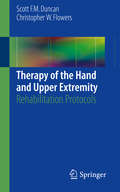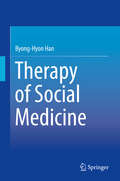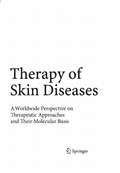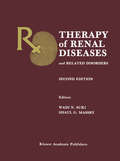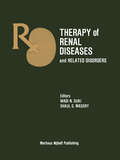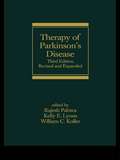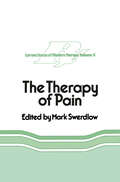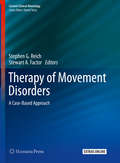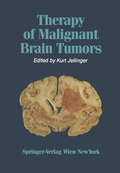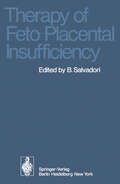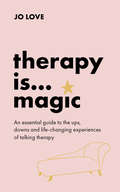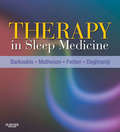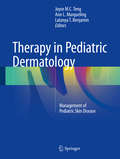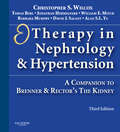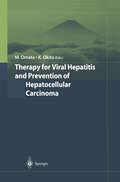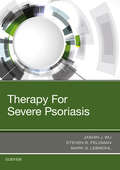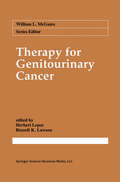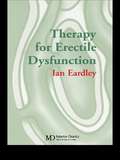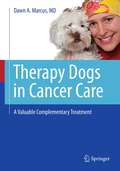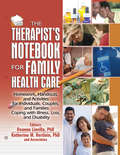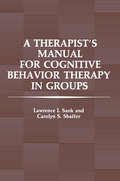- Table View
- List View
Therapy of the Hand and Upper Extremity: Rehabilitation Protocols
by Scott F. Duncan Christopher W. FlowersPresenting over 100 rehabilitation protocols for the hand and upper extremity in an easy-to-use, step-by-step format, this practical reference provides surgeons and therapists alike with a go-to source for the therapy technique or strategy appropriate for their patients. Covering injuries from the shoulder, elbow, wrist, hand and fingers, each protocol includes bullet-pointed steps in daily or weekly increments following the injury or surgery and are inherently adaptable to the specific surgical intervention or rehabilitation requirement. Procedures following arthroplasty, extensor and flexor tendon injuries, fractures and dislocations, ligament and soft tissue injures, and nerve compression syndromes are among the many and multifaceted therapies presented. This book will be an invaluable resource for the orthopedic surgeon, hand surgeon, physical therapist, occupational therapist, hand therapist and any active clinician treating injuries to the hand and upper extremity.
Therapy of Social Medicine
by Byong-Hyon HanThis book introduces novel and groundbreaking theories on social medicine, social medicine therapy and pharmacogelotology. Aimed at improving the global health care system in terms of cost-effectiveness and efficiency, the research included in this book represents a paradigm shift from traditional drugs to social medicine. Tracing the history of social medicine, from Natural Healing Power (NHP), Oriental Medicine’s vitalism, to Homeostasis (Natural Healing Strength) and Reciprocity (Social Healing Strength), the book first focuses on laying the theoretical foundations. It then highlights how social medicine can be specialized into various social medicine therapies (i.e., aromatherapy, stone therapy, diet therapy, exercise therapy, light therapy, etc.), just like stem cells. This is followed by arguments that 21st century pharmacy should be a harmonious system where the replacement of traditional drug products (i.e., herbal, chemical, and biological products) with new social medicine takes precedence. To that end, the author focuses on the '4+2 system' with 4 representing diet, body, stress, and facial-image control, and 2 representing the complementary and alternative medical methods of evacuation(-) and filling(+). In the context of pharmacogelotology, the book then goes on to present findings on theories of laughter and laughter therapy practices, which are systematically examined and described in detail. Finally, it calls for the development of social-medicine structures by governments that aim to help local authorities use their resources effectively, and for local governments to establish the long-term planning on social-medicine therapy for healthy ageing.
Therapy of Skin Diseases: A Worldwide Perspective on Therapeutic Approaches and Their Molecular Basis
by Thomas Krieg David R. Bickers Yoshiki MiyachiBased on the understanding of the molecular basis of skin diseases, this truly international book supports the reader to understand the mode of action of new and established therapies. Thus, by explaining the molecular pathology with its applications for therapy, it provides the reader with an up-to-date knowledge of the therapy of skin disease and helps to understand ongoing and new developments in the field. Written and edited by international and renowned dermatology experts from Europe, America and Asia, it also includes regional concepts of therapies.The reader-friendly structure allows the reader to pick up the information quickly; for example, each chapter highlights practical hints for indications and applications. This lavishly illustrated book will support the reader to choose the most appropriate therapy for the patient and to reach a better treatment outcome. It will be an indispensable resource for dermatologists in university departments as well as in clinical practice.
Therapy of Renal Diseases and Related Disorders
by Shaul G. Massry Wadi N. Suki"Where are all these kidney patients coming from? A few perfection the study of the urinary sediment, clinically years ago we had never heard of kidney disease and now practical kidney function tests, and the natural history of a number of kidney diseases including glomerulonephritis. you are speaking of patients in the hundreds of thousands and indeed potentially millions. " My reply, not meant to William Goldring, Herbert Chasis, Dana Atchley, and others studied the effects of hypertension, endocarditis, be grim, was "From the cemetery, Sir. " This is a summary and circulatory diseases on the kidney and spawned suc of some Congressional testimony lance gave on behalf of extending kidney disease under Medicare. Where indeed cessive generations of alert clinical investigators, who be gan to chronicle the natural histories of a wide variety of were all the patients with kidney disease in the United States before World War II? They were certainly not kidney diseases. Quantitative studies of renal function flourished under a school headed by Homer Smith, and under the care of nephrologists! Nephrology was not listed in the questionnaires for any state or the American Medi surprisingly precise techniques were developed for study ing a whole range of explicit nephron functions. Imagine cal Association as a subspecialty or even as a special the joy with the advent of vascular catheterization to be interest.
Therapy of Renal Diseases and Related Disorders
by Wadi N. Suki Shaul G. Massry'Where are all these kidney patients coming from? A Atchley and others studied the effects of hypertension, endocarditis, and circulatory diseases on the kidney and few years ago we never heard of kidney disease and now you are speaking of patients in the hundreds of thou spawned successive generations of alert clinical investi sands and indeed potentially millions'. My reply, not gators who began to chronicle the natural histories of a meant to be grim, was 'From the cemetery, Sir'. This is wide variety of kidney diseases. Quantitative studies of a summary of some Congressional testimony I once renal function flourished under a school headed by Homer Smith, and surprisingly precise techniques were gave on behalf of extending kidney disease under Medi care. Where indeed were all the patients with kidney developed for studying a whole range of explicit nephron disease in the United States before World War II? They functions. Imagine the joy with the advent of catheteri were certainly not under the care of Nephrologists! zation to be able to apply extraction ratios and the Fick Nephrology was not listed in the questionnaires for any principle in a precise way to an organ such as the kidney State or the American Medical Association as a subspe by sampling arterial blood, venous blood and the output of the urine! One had a quantitative handle on the entire cialty or even as a special interest.
Therapy of Parkinson's Disease
by Rajesh Pahwa Kelly E. Lyons William KollerA comprehensive review of current tactics in the therapeutic management of Parkinson's disease, this volume offers summaries of salient research findings as well as contemporary attitudes and practical advice from field specialists. The well-timed Third Edition is expanded and topically reorganized to register trends and progress in anti-parkinsoni
Therapy of Parkinson's Disease
by Rajesh Pahwa Kelly E. Lyons William C. KollerA comprehensive review of current tactics in the therapeutic management of Parkinson's disease, this volume offers summaries of salient research findings as well as contemporary attitudes and practical advice from field specialists. The well-timed Third Edition is expanded and topically reorganized to register trends and progress in anti-parkinsoni
The Therapy of Pain (Current Status of Modern Therapy #6)
by MarkSwerdlowThe past few years have seen the publication of a large number of articles and not a few books on the subject of relief of intractable pain. New ideas have been put forward on pain mechanisms, new methods of treatment have been reported and improved results c1aimed, and a growing catalogue of complications oftreatment has been recorded. The vast and expanding literature on the subject poses for the reader the dual problems of surveil lance and of assessment. The object of the present book is to provide a critical and constructive review of current writings and ideas on a wide range of aspects of the nature of intractable pain, particularly of present day practice and new ideas on treatment. Each chapter is written by an acknowledged authority and the approach throughout is practical rather than academic. In editing the individual chapters an effort was made to achieve a contemporary approach and to eliminate material which was unduly historicalor retrospective in content. At the same time the individ ual style of the authors was retained as far as possible. For decades chronic pain has been a therapeutic 'no man's land'. For the surgeon pain was an unfortunate complication wh ich not infrequently followed surgery; for the physician it was a distressing symptom in a number of disease syndromes; to the psychiatrist it was one of a number of features in many cases of mental illness.
Therapy of Movement Disorders: A Case-Based Approach (Current Clinical Neurology)
by Stephen G. Reich Stewart A. FactorThis case-based text provides treatment approaches to common and uncommon movement disorders. The first two parts of the book are devoted to the wide spectrum of motor and non-motor problems encountered in caring for people with Parkinson’s disease, as well as Parkinsonian syndromes. Next are parts with chapters addressing essential and other tremor disorders followed by management of the various dystonic syndromes and other hyperkinetic disorders including chorea, tics, and myoclonus. Other disorders covered are drug-induced movement disorders, psychogenic movement disorders, Wilson’s disease, hemifacial spasm and more. Authored by experts globally, this practical guide will help physicians, other healthcare professionals and trainees care for patients with a wide spectrum of movement disorder related problems.
Therapy of Malignant Brain Tumors
by Prof. Dr. Kurt JellingerThe tumors of the brain similar to other pathological changes of that particular organ claim for a separate position in scientific medicine regarding biology, morphology, features of clinical manifestation, diagnostics and therapy. During the past years due to rapid progress in basic neurosciences and medical biotechnics the situation of the neuroclinician in front of brain tumors has been dramatically changed. The prerequisites for early and accurate diagnosis as well as for successful treatment also of malignant neoplasms have increased and remarkably improved. At the same time the information necessary for an appropriate pragmatic use of the available cognitive methods and therapeutic means increased along the same scale and is permanently being critically modified or changed due to fundamental new insights which come up in always shorter intervals. These facts necessitate the preparation of publications in which the state of the art is presented in possible completeness, systematic order and proper disposability for rational management and therapeutic strategies.
Therapy of Feto-Placental Insufficiency: I. International Symposium Parma, May 19th and 20th 1973
by Bruno SalvadoriThe progess in biological sciences and its applications in obstetrics in the last twenty years have formed the base for feto-placental semeiotics. In this way, it has been possible to diagnose placental insufficiency even in patients whose clinical conditions gave all the indications of a perfectly normal feto-placental condition. On the other hand, observations have shown that in certain conditions some deficiencies can im prove until normality is reached again. On the basis of the above one feels justified to talk about the therapy of feto-placental insufficiency. Until now this therapy has been aimed at the obstetrical pathology of the mother. Our aim is to illustrate the various steps which should be taken to execute an efficient therapy of the conditions relating to the pathology of the fetus, realizing full well that fetal pharmacology is only now being taken into consideration. The various steps to be taken, the length of therapy, and all the other correlated factors are still the object of individual ex periences, and we are fortunate to have amongst us researchers in this field who have accepted our invitation and can supply us with their personal experiences which can also be compared. The first international symposium on the therapy of feto-placental insufficiency has been organized in conjunction with the Samil-Pabyrn Foundation whom I would lik to thank, and especially so its president, Mrs. INGE SAXON-MILLS.
Therapy is... Magic: An essential guide to the ups, downs and life-changing experiences of talking therapy
by Jo LoveIn this part memoir, part mental health resource and how-to guide, Jo Love throws opens the door of her therapist's office and shines a light on what exactly goes on in the therapy room. With the help of experts, including her very own therapist, Jo opens a rare window into the real world of therapy, unpicking the magical powers that enabled her to re-find her own voice, restored her resilience through the cloudiest days and ultimately saved her from her own mind. Each chapter includes:- A therapy list where Jo shares her knowledgeable insights into therapy- Inspirational voices in the mental health space on the life-changing effects of therapy - A 'From the Other Chair' section featuring expert opinions from mental health professionals- 'Need Help Now' suggestions Therapy is ... Magic moves away from the stigma sometimes associated with seeking help, and shines a light on the emotional and physical benefits of talking therapies. Jo Love shows us that with professional guidance we can heal ourselves and the relationships we have, tackle addictions and trauma, and save our minds.
Therapy in Sleep Medicine E-Book: Expert Consult - Online And Print
by Teri J. Barkoukis Jean K. Matheson Richard Ferber Karl DoghramjiTherapy in Sleep Medicine, by Drs. Teri J. Barkoukis, Jean K. Matheson, Richard Ferber, and Karl Doghrami, provides the clinically focused coverage you need for rapid diagnosis and effective treatment of sleep disorders. A multidisciplinary team of leading authorities presents the latest on sleep breathing disorders (including obstructive sleep apnea), neuropharmacology, parasomnias, neurologic disorders affecting sleep, sleep therapy for women, sleep therapy in geriatric patients, controversies, and future trends in therapy in a highly illustrated, easy-to-follow format.Diagnose and treat patients effectively with complete coverage of the full range of sleep disorders. Find diagnostic and treatment information quickly and easily thanks to a highly illustrated, easy-to-read format that highlights key details. Stay current on discussions of hot topics, including sleep breathing disorders (including obstructive sleep apnea), neuropharmacology, parasomnias, neurologic disorders affecting sleep, sleep therapy for women, sleep therapy in geriatric patients, controversies, and future trends in therapy. Tap into the expertise of a multidisciplinary team of leading authorities for well-rounded, trusted guidance.
Therapy in Pediatric Dermatology: Management of Pediatric Skin Disease
by Joyce M.C. Teng Ann L. Marqueling Latanya T. BenjaminThis book addresses the need for comprehensive review of therapeutic options that are known to be efficacious in the management of cutaneous diseases in children. It summarizes evidence-based literature on clinical responses among pediatric patients, including age-appropriate management strategies. Included is review of the extraordinary developments in understanding of the genetics and pathogenesis of many cutaneous disorders during the past decade, the novel therapeutic options and repurposing of old drugs, and the management of some of the most challenging skin disorders.Therapy in Pediatric Dermatology: Management of Pediatric Skin Disease is a succinct, user-friendly, and up-to-date therapeutic dermatologic textbook for physicians who care for children with skin disorders. Each skin condition is discussed with investigative and treatment recommendations in mind and provided based on extensive review of the literature. This book will provide unbiased, yet concise, information that is valuable to practitioners who manage pediatric patients in their practices.
Therapy in Nephrology and Hypertension E-Book: A Companion to Brenner & Rector's The Kidney
by Christopher S. WilcoxThoroughly revised, the new edition of this companion to Brenner & Rector’s The Kidney equips you with today’s guidance to effectively manage renal and hypertension patients. International authorities emphasize the specifics of treatment while presenting field-tested advice on the best therapeutic strategies available. New chapters reflect the latest evidence impacting current clinical issues, while a new design helps you reference the information more easily.Presents the most comprehensive text available on nephrology and hypertension treatment for a convenient single source that is easy to consult. Features the evidence-based guidance of leading authorities for making more informed clinical decisions. Offers in-depth discussions and referenced coverage of key trials to help you analyze the results and the evidence provided. Provides treatment algorithms and tables of commonly used drugs in each chapter for quick-access expert advice on arriving at the best and most appropriate treatment regimen.Offers new chapters on erectile and sexual dysfunction, transplant immunology and immunosuppression, dietary salt restriction, and systematic vasculitis and pauci-immune glomerulonephritis that reflect new evidence impacting current clinical issues. Presents the contributions of newly assigned section editors—authorities in their subspecialty fields—who offer you the benefit of their practice-proven expertise. Provides rationales for the therapies presented to help you choose the most effective treatment for each patient.
Therapy for Viral Hepatitis and Prevention of Hepatocellular Carcinoma
by M. Omata, K. OkitaThe liver has an important role in nutritional homeostasis, and it is well known that liver diseases can lead to abnormalities in the nutrient metabolism and to subsequent malnutrition. Because malnutrition is particularly prevalent in patients with liver cirrhosis, proper nutritional assessment and support for cirrhotic patients is essential. This collection of research and clinical findings on nonalcoholic steatohepatitis (NASH) and nutritional therapy contains significant new findings in several fields. As NASH frequently causes liver cirrhosis, the nutritional aspects of its treatment are discussed. Other areas covered include nonalcoholic fatty liver, the role of leptin in the pathogenesis of NASH, restricted diets and exercise therapy, mammalian targets of the peptide rapamycin, and genetic factors influencing the development of NASH. This book is intended to be of particular relevance to researchers and those practicing in the field.
Therapy for Severe Psoriasis E-Book: Expert Consult
by Jashin J. Wu Steven R. Feldman Mark G. LebwohlA brand-new title in the field of dermatology, Therapy for Severe Psoriasis provides the ultimate coverage of the treatment options available for today's most serious cases, including biologics and oral therapies. It features discussions of the newest drug therapies, recent FDA-approved biosimilars, and combination approaches to care, while an overview chapter was designed to aid those new to the field in understanding the nuances of difficult-to-treat subtypes of psoriasis. Comprehensive and focused, Therapy for Severe Psoriasis will be a welcome addition to the library of any dermatologist seeking in-depth information on the challenges of this condition.Each of the 16 chapters includes either an in-depth focus on a single therapy or an overview of a unique aspect of psoriasis, including: UVB therapy, methotrexate, acitretin, cyclosporine, apremilast, etanercept, infliximab, adalimumab, ustekinumab, secukinumab, and ixekizumab.Takes an evidence-based approach to hard-to-treat severe psoriasis.Discusses the newest drug therapies (such as ixekizumab), plus recent FDA-approved biosimilars, a topic unique to this particular psoriasis text.Presents combination approaches for instances when standard treatments are not successful.Includes an overview chapter to help beginners understand the nuances of the disorder.
Therapy for Genitourinary Cancer (Cancer Treatment and Research #59)
by Russell K. Lawson HerbertLeporWhere do you begin to look for a recent, authoritative article on the diag nosis or management of a particular malignancy? The few general oncology textbooks are generally out of date. Single papers in specialized journals are informative but seldom comprehensive; these are more often preliminary reports on a very limited number of patients. Certain general journals frequently publish good in-depth reviews of cancer topics, and published symposium lectures are often the best overviews available. Unfortunately, these reviews and supplements appear sporadically, and the reader can never be sure when a topic of special interest will be covered. Cancer Treatment and Research is a series of authoritative volumes that aim to meet this need. It is an attempt to establish a critical mass of oncology literature covering virtually all oncology topics, revised frequently to keep the coverage up to date, and easily available on a single library shelf or by a single personal subscription. We have approached the problem in the following fashion: first, by dividing the oncology literature into specific subdivisions, such as lung cancer, genitourinary cancer, pediatric oncology, etc.; and second, by asking eminent authorities in each of these areas to edit a volume on the specific topic on an annual or biannual basis. Each topic and tumor type is covered in a volume appearing frequently and predictably, discussing current diag nosis, staging, markers, all forms of treatment modalities, basic biology, and more.
Therapy for Erectile Dysfunction: Pocketbook
by Ian EardleyErectile dysfunction is a common problem that may result from a number of medical conditions. With increasing public awareness, men with ED are seeking medical help. This pocketbook will assist the physician in treating and managing ED effectively with either drugs or devices.
Therapy for Erectile Dysfunction: Pocketbook
by Ian EardleyErectile dysfunction is a common problem that may result from a number of medical conditions. With increasing public awareness, men with ED are seeking medical help. This pocketbook will assist the physician in treating and managing ED effectively with either drugs or devices.
Therapy Dogs in Cancer Care: A Valuable Complementary Treatment
by Dawn A. MarcusDogs that visit patients with cancer have been convincingly shown to reduce stress, loneliness, and mood disturbance that may complicate cancer care. In addition, dogs may provide important motivation for patients to maintain rehabilitation programs that have been shown to reduce cancer risk and improve cancer survival. Outlining all of these issues and many more, Therapy Dogs in Cancer Care: A Valuable Complementary Treatment is a ground-breaking, highly innovative addition to the literature on cancer care. Detailing a comprehensive summary of truly impressive research demonstrating the ability of dogs to serve an important therapeutic role within the cancer arena and in other serious medical conditions, the text provides highly practical advice and very helpful “tips” to ensure that those who wish to employ dogs to assist the cancer patient have the necessary knowledge and “tools” to optimize outcomes. Authored by Dawn A. Marcus, MD, an expert in both pain management and health improvement through human and dog interaction, Therapy Dogs in Cancer Care: A Valuable Complementary Treatment is an extremely well-organized, well-researched, and highly readable book. Providing practical suggestions to effectively incorporate dogs into cancer care, with detailed instructions about requirements for therapy dogs to ensure visits are safe and limit unwanted spread of infection, Therapy Dogs in Cancer Care: A Valuable Complementary Treatment is an invaluable reference that will inform and delight both the clinician desiring a “how-to” text as well as the casual reader.
The Therapist's Notebook for Family Health Care: Homework, Handouts, and Activities for Individuals, Couples, and Families Coping with Illness, Loss, and Disability
by Deanna Linville Katherine M. HertleinEffective interventions to help your clients deal with illness, disability, grief, and loss The Therapist’s Notebook for Family Health Care presents creative interventions for working with individuals, couples, and families dealing with illness, loss, and disability. This book offers creative resources like homework, handouts, and activities, and effective, field-tested interventions to provide counselors with useful information on specific family dynamics and topics. It equips mental health clinicians with practical therapeutic activities to use in their work with clients struggling with health care or grief issues. The effects of illness, disability, and loss in everyday life can be profound. Besides the individual repercussions, these challenges also affect the lives of the family and social networks of those individuals experiencing them. The Therapist’s Notebook for Family Health Care brings together the knowledge and experience of over 30 experts in the field for a unique collection that therapists and clients alike will find immediately useful. Situated in four unique subject-specific sections for quick reference, this text covers a broad scope of common problems. Also included is a bonus section focusing on thoughtful suggestions for self-care and professional development. Some of the many topics and techniques presented in The Therapist’s Notebook for Family Health Care include: conducting interviews using the biopsychosocial-spiritual method using the Family System Test (FAST) to explore clients’ experiences with their healthcare system and providers increasing social support to manage chronic illness coping and adapting to developmental changes, challenges, and opportunities using a patient education tool in family therapy helping children (and their families) to manage pain through knowledge and diaphragmatic breathing creating a personal “superhero” for a child as a means to empowerment and relief of anxiety facilitating family problems using scatterplots building functional perspective of self and others in clients with Asperger Syndrome quilting as a meaning-making intervention for HIV/AIDS empowering terminally-ill patients to say goodbye to their young children in meaningful ways and many more!With a wealth of tables, charts, handouts, and bibliotherapy resources for clients; readings and resources for clinicians; and case vignettes, The Therapist’s Notebook for Family Health Care is an excellent resource for a wide variety of practitioners, including, counselors, psychologists, social workers, grief workers, hospice workers, health psychologists, and medical social workers. It is also an ideal text for psychotherapy and counseling students and educators.
The Therapist's Notebook for Family Health Care: Homework, Handouts, and Activities for Individuals, Couples, and Families Coping with Illness, Loss, and Disability
by Deanna Linville Katherine M. HertleinEffective interventions to help your clients deal with illness, disability, grief, and loss The Therapist’s Notebook for Family Health Care presents creative interventions for working with individuals, couples, and families dealing with illness, loss, and disability. This book offers creative resources like homework, handouts, and activities, and effective, field-tested interventions to provide counselors with useful information on specific family dynamics and topics. It equips mental health clinicians with practical therapeutic activities to use in their work with clients struggling with health care or grief issues. The effects of illness, disability, and loss in everyday life can be profound. Besides the individual repercussions, these challenges also affect the lives of the family and social networks of those individuals experiencing them. The Therapist’s Notebook for Family Health Care brings together the knowledge and experience of over 30 experts in the field for a unique collection that therapists and clients alike will find immediately useful. Situated in four unique subject-specific sections for quick reference, this text covers a broad scope of common problems. Also included is a bonus section focusing on thoughtful suggestions for self-care and professional development. Some of the many topics and techniques presented in The Therapist’s Notebook for Family Health Care include: conducting interviews using the biopsychosocial-spiritual method using the Family System Test (FAST) to explore clients’ experiences with their healthcare system and providers increasing social support to manage chronic illness coping and adapting to developmental changes, challenges, and opportunities using a patient education tool in family therapy helping children (and their families) to manage pain through knowledge and diaphragmatic breathing creating a personal “superhero” for a child as a means to empowerment and relief of anxiety facilitating family problems using scatterplots building functional perspective of self and others in clients with Asperger Syndrome quilting as a meaning-making intervention for HIV/AIDS empowering terminally-ill patients to say goodbye to their young children in meaningful ways and many more!With a wealth of tables, charts, handouts, and bibliotherapy resources for clients; readings and resources for clinicians; and case vignettes, The Therapist’s Notebook for Family Health Care is an excellent resource for a wide variety of practitioners, including, counselors, psychologists, social workers, grief workers, hospice workers, health psychologists, and medical social workers. It is also an ideal text for psychotherapy and counseling students and educators.
A Therapist’s Manual for Cognitive Behavior Therapy in Groups
by L.I. Sank C.S. ShafferOne of the great advantages of rational-emotive therapy (RET) and cog nitive behavior therapy (CBT) is that they frequently employ psycho educational methods-including bibliotherapy, workshops, lectures, courses, recordings, and films. I created RET at the beginning of 1955 after I had abandoned the practice of psychoanalysis because I found it to be highly inefficient and philosophically superficial. Being almost addicted to one-to-one therapy as a result of my analytic training and experience, I at first did RET only with individual clients and found this pioneering form of CBT considerably more effective than the other ther apies with which I had experimented. By 1957, however, I realized that RET could be taught to large num bers of persons through self-help books and articles and that RET -ori ented writings could not only prove valuable to the general public but that they could also be successfully employed to hasten and intensify the therapy of my individual clients. I therefore wrote a number of RET self help books-especially How to Live with a Neurotic (1957), Sex without Guilt (1958), A New Guide to Rational Living (with Robert A. Harper; original edition, 1961), and A Guide to Successful Marriage (with Robert A. Harper, 1961).
Therapist's Guide To Self-care (PDF)
by Lillie WeissPsychotherapy is an increasingly stressful profession. Yet therapists spend most of their time helping clients deal with their stress, not caring for their own. This book is designed as a tool for the experienced counselor, junior therapist, and graduate student, as the issues confronted and discussed herein are relevant to anyone in the field, regardless of experience or expertise. Dr. Weiss has written a book in an easy, conversational tone, filled with concrete examples and blending research findings, clinical experience and theoretical approaches into practical suggestions and sound advice. The book is divided into three parts, discussing therapist concerns and questions that are continually raised, and providing practical tools based on clinical experience and research findings. It will be useful to all mental health professionals who have felt the strain of their practice.
